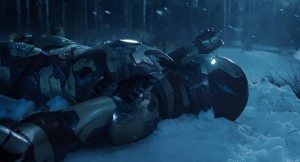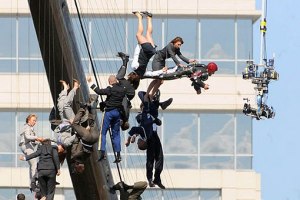Iron Man 3 (2013) Dir. Shane Black
[contains spoilers]
Already racing ahead at the box office, Iron Man 3 has been celebrated for capitalising on the good work Robert Downey Jr. put into The Avengers (2012) and is seen as revitalising the Iron Man franchise after the lacklustre reception of Iron Man 2. Like a number of sequels (Step Up, Men in Black) the third instalment is serendipitously in 3D and Iron Man 3 seems happy to make use of all the spectacular effects that stereoscopy can add to the contemporary action blockbuster. Also like other franchises that now have stereoscopic versions, the dynamic change to the visual field that 3D filmmaking brings is missing from any discussion beyond that of advances in special effects. Iron Man 3 begins with a return to 1999 and this is made emotively nostalgic by the use of the iconic 1999 dance hit, Eiffel 65’s ‘Blue (Da Ba Dee),’ as the film passes over the Paramount credits and into the diegesis. At the same time that we are given a greater back-story to the Iron Man history we are naturalised into feeling as if we have always seen Iron Man in 3D. Even though protagonist Tony Stark’s voice over takes us through this journey in a form of direct address, no mention is given of this change in visual field from the previous ‘flat’ incarnation of Iron Man’s diegesis. It is an aspect that transpires in all film franchises when technology is updated from one film to the next: think of the changes to Gollum that have occurred from the first Lord of the Rings (2001) to the more recent The Hobbit (2012). The duty of the film is to make us believe that we have always seen the characters and their settings through the lens of the most up-to-date technology and, if successful, we will forget what the previous incarnations looked like. From now on, Tony Stark will most likely seem as if he has always been in stereoscopic depth.
To this end, Iron Man 3 includes a number of stereoscopic tendencies that are being developed and re-envisioned again and again in contemporary action blockbusters: when Stark and his friend James Rhodes have an early conversation at a bar, the spatial configurations between characters and ordinary objects in the interior space are sculpted in depth; action scenes throw large quantities of embers and other burning material towards the audience in negative parallax; slow motion in explosion scenes allows stereoscopic debris to scatter around the auditorium in dramatic and dynamic ways; the protagonist is thrown underwater so that the thick tactile quality of liquid in stereoscopy can be utilised; and snow storms when Stark travels north create a palpable screen space that encloses both viewer and characters.
The film also portrays extensive numbers of holographic screening devices that have been visualised in stereoscopic filmmaking since Avatar (2009). Although these devices are ostensibly used to further plot points in the way they allow data communication, they seem more concerned with showing spectacular digital visual fields that are not yet available in the real world. The first of these is the brain imaging device that antagonist Aldrich Killian brings with him when meeting Starks’s partner Pepper Potts. He first shows her a holographic display of the universe and then one of the interior of his brain. Both imaging sets take up the majority of the office where they are meeting and the placement of much of the imaging in negative parallax means that the data fields seem within touching distance of the viewer. In a number of shots, Potts and Killian are placed inside the imaging set and, even though the images are only in front of us, it seems as if the audience is with them inside the visualisation of the brain. All of this is possible because the transparent nature of the holograms allows objects to be seen through and behind them. When combined with stereoscopic depth cues, there is a dynamic play between the different depth planes simultaneously available in the visual field. Although the brain display is the most vibrant use of holograms in the film, holographic displays return throughout. Stark has a miniature holographic display that functions like a mobile phone and both he and Rhodes have holographic displays inside their Iron Men suits. When Stark uses a holographic plan to recreate the explosion that occurred at Hollywood’s Chinese Theatre, the spatial mapping he undertakes becomes clearer in the stereoscopic depth configurations.
The one major difference between Iron Man 3 and other contemporary films using similar visual technology is the sense of self-reflexive play and humour throughout the film. The film’s humour does not just play with the superhero genre but also plays with the technological fetishization at work in many other 3D blockbusters. A common visual theme in recent films has been the use of a steam punk aesthetic to celebrate the tangible and material components of hard technology (Hugo (2011), John Carter (2012) and The Three Musketeers (2011)) or hyper-fast technological components (Transformers: Dark of the Moon (2011), G.I. Joe: Retaliation (2012), Resident Evil: Afterlife (2010) Tron: Legacy (2010)). In a manner that reverts the trend for these aesthetics, Iron Man 3 enters into a type of camp technological aesthetic midway through the film. After Stark is stranded in Tennessee without his Iron Man suit he builds new weapons from a number of kitsch items: a young girl’s cartoon-faced electronic watch, Christmas baubles, and a roughly hewn home-made taser.
Yet, as humorous as Iron Man 3 is, it does suffer from the common problem in technologically themed action blockbuster franchises: where to go to when the hero’s technological capacity and skills keep getting better and better. It was a problem that occurred in the final movie instalment of The Matrix: The Matrix Reloaded (2003) when Neo was given the ability to fly. After that point it seemed illogical that he would bother with any of the hand-to-hand combat that was part of his style and further action sequences were undermined by the knowledge that he should be able to fly his way out of danger. In Iron Man 3, Stark’s decision to call on his hidden store of multiple Iron Men when all seems lost begs the question of why he didn’t initiate the army days earlier. The army also begs the question of how there could ever be any true threat to Stark if he has the capacity to build such a tremendous force. In attempting to get around the pitfalls the plot has set up, Iron Man 3 creates a narrative around Pott’s fear of the technology and its potential to go wrong in order to negate these problems. Nonetheless, it seems as if these aspects have been tacked on in order to get the plot out of a technological end-point that it has worked itself into.















